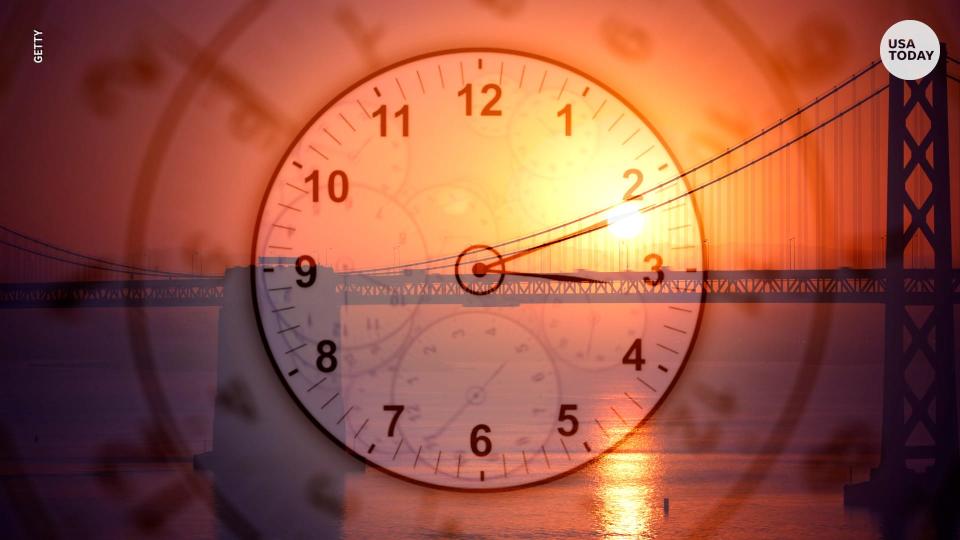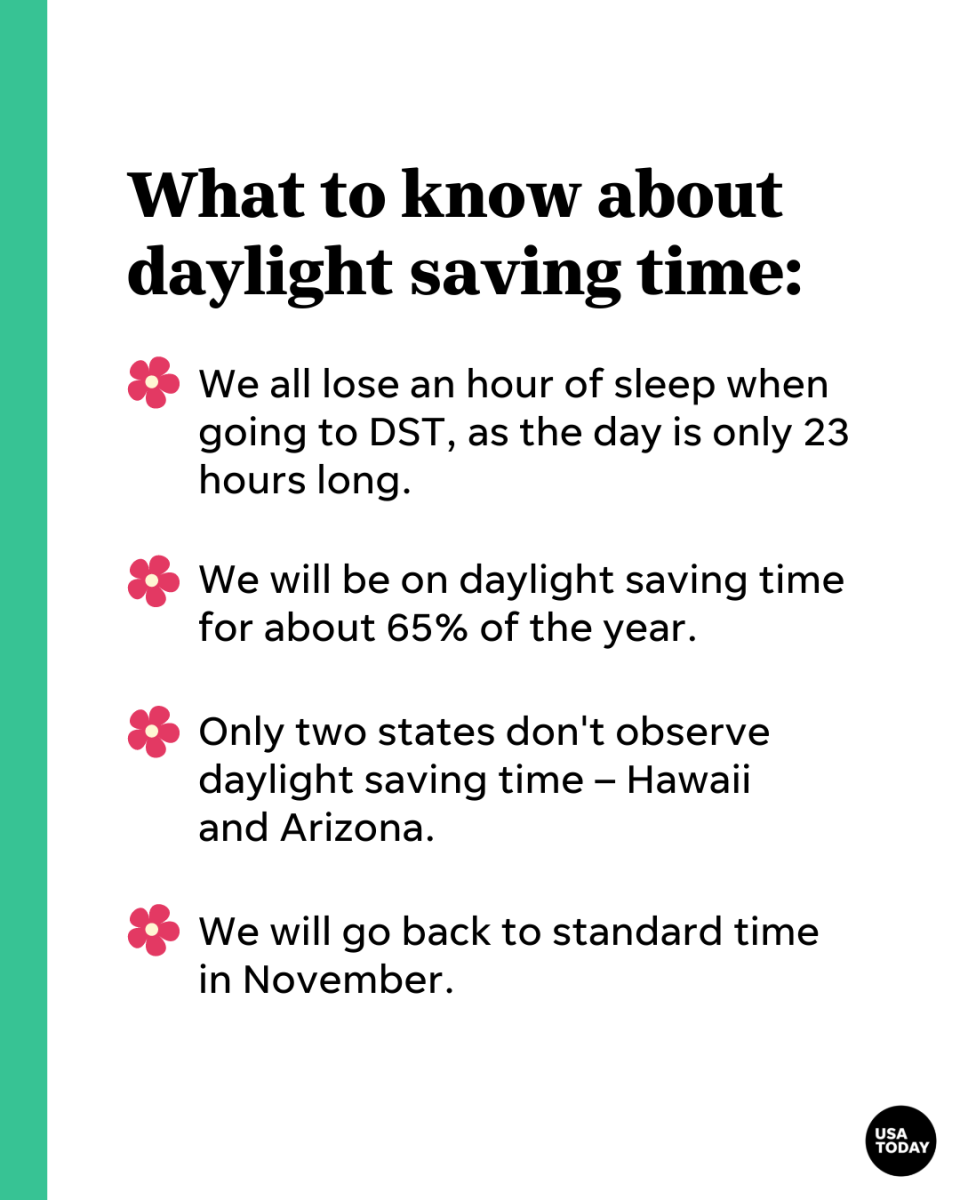Time change 2024 will spring forward next month in Kentucky. What to know about DST
Daylight Saving Time is rapidly approaching and Kentuckians will soon have to change those pesky clocks.
The good news is we escape the dark hours of winter, but there are some side effects even if spring can't get here soon enough.
What is daylight saving time saving? Hint: it may not actually be time or money
Here's what you need to know about DST in 2024:
When does the Daylight Saving time change 2024 occur in U.S.?
Participating states turn clocks forward an hour on the second Sunday in March during the spring. Daylight Saving Time ends on the first Sunday of November in the fall of each year and that's when states turn clocks back an hour.
When do we spring forward for DST 2024?
In the U.S., clocks will officially spring forward at 2 a.m. Sunday, March 10, 2024.
Do I gain or lose an hour of sleep for Daylight Savings Time at 2 a.m. March 10, 2024?

We lose an hour of sleep when the clocks "spring forward" and are turned ahead at 2 a.m. for one hour when Daylight Saving Time begins.
In the fall when DST ends, clocks "fall back" an hour in November. That is when people gain an hour of sleep.
When does Daylight Savings 2024's time change fall back?
Clocks fall back on Sunday, Nov. 3 in 2024.
Why does Daylight Saving Time change at 2 a.m.?
In an interview with Time Magazine, author Michael Downing cited his book, "Spring Forward: The Annual Madness of Daylight Saving Time," to explain how Amtrak and the railroads were the main reason clocks change at 2 a.m. for DST.
There were no trains leaving the station at 2 a.m. on Sundays in New York City when Daylight Saving Time was established.
"Sunday morning at 2 a.m. was when they would interrupt the least amount of train travel around the country,” Downing said.
Why does daylight saving time exist?: Unpacking the century-long beef over DST
Which U.S. states don't change clocks for Daylight Saving Time?
As of July 25, 2022, the U.S. Department of Transportation noted that only Hawaii and parts of Arizona do not participate in daylight saving time. The Navajo Nation is the lone exception in Arizona.
The territories of American Samoa, Guam, Northern Mariana Islands, Puerto Rico and the Virgin Islands also do not participate.
According to the website, states may exempt themselves from observing daylight saving time by state law in accordance with the Uniform Time Act, as amended.

Daylight Savings Time and time change in Kentucky
Kentucky first observed daylight saving time in 1918, when the Standard Time Act established daylight saving time to conserve electricity during World War I. After the war was over, daylight saving was no longer national law and became a local option.
Between 1918 and today, Kentucky observed daylight saving time for 75 years, according to timeanddate.com. For a while, cities across Kentucky were inconsistent, with some observing the time change and others not.
But starting in 1970, Time and Date AS has tracked observance of daylight saving time in Kentucky every year.
Over the years, researchers have tried to tie your body getting an hour less of sleep that night to a variety of issues, including an increase in car crashes and health problems such as heart attacks and strokes.
In 2019, Kentucky Republican Reps. Bart Rowland of Tompkinsville and Brandon Reed of Hodgenville pre-filed a bill to do away with resetting clocks every six months and instead use daylight saving time all year long. To do so, however, requires authorization by the federal government.
Under federal law, states are allowed not to observe daylight saving time, with Arizona and Hawaii being the lone states to do so. States are not allowed to stay on daylight time throughout the year.
When does Daylight Saving Time end permanently?
Despite the Sunshine Protection Act being unanimously approved by the U.S. Senate in 2022, there is no permanent end in sight.
The bill was not signed into law by the U.S. House of Representatives, citing other priorities that needed to be addressed before tackling DST, according to The Hill. Thus, the bill has not been signed into law by President Joe Biden.
Rep. Frank Pallone Jr. (D-N.J.) told The Hill in July that efforts to find a consensus for Daylight Saving Time continue to fall flat with an emphasis on geographical issues rather than political party lines.
"The problem is that a lot of people say to me, ‘Oh, we should just have, you know, we shouldn’t switch back and forth, we should just have standard or daylight saving,’ but then they disagree over which one to enact," Pallone told The Hill.
"And so that’s the problem. We need a consensus that if we’re gonna have one time, what is it? And I haven’t been able to get a consensus on that."
A 2023 version of the Sunshine Protection Act sat idle in the House of Representatives for the entire year.
When is spring 2024?: We're sick of winter. When's spring already?
Did Daylight Saving Time start because of farmers?
No, according to almanac.com.
"Many Americans wrongly point to farmers as the driving force behind Daylight Saving Time. In fact, farmers were its strongest opponents and, as a group, stubbornly resisted the change from the beginning," Catherine Boeckmann wrote for almanac.com.
"When the war ended, the farmers and working-class people who had held their tongues began speaking out. They demanded an end to Daylight Saving Time, claiming it benefited only office workers and the leisure class. The controversy spotlighted the growing gap between rural and urban dwellers."
Chris Sims is a digital content producer for Midwest Connect Gannett. Follow him on Twitter: @ChrisFSims.
This article originally appeared on Journal Star: Daylight Savings 2024: Time change to spring forward, when clocks turn

